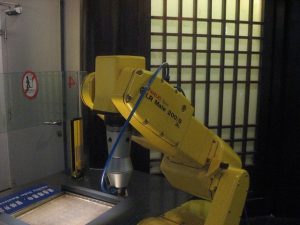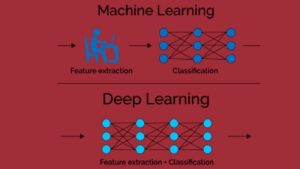30 A.I. Technology
Kyle McCormick
The Rise of Artificial Intelligence
30.1 Introduction
AI technology has been developing into one of the fastest growing technological fields in our world today. AI was invented in 1956 by John McCarthy, but did not become as impactful till the 1970’s. It is a broad field that includes machine learning and deep learning technologies. It is a technology that affects our society greatly and comes in many forms. Whether it be cybersecurity or just Siri on an iPhone it is involved in most lives daily. As stated by Frey and Osborne “Technological developments have significantly advanced since the 1990’s with more significant improvement in the way people perform different tasks” (Frey and Osborne 2017). In the 1990s AI tech popularized even more and became mainstream. This technology only improve our life and make common tasks much easier. Countless tasks today rely on technology and more specifically AI technology to expediate the process. It allows us to do less and complete tasks and objectives more efficiently and effectively. AI is more efficient that an actual human worker because the technology completes the job that a human once did and “learns” as the system faces a problem. In other words, the software updates automatically to be more efficient. This is a particularly important aspect of the technology because it becomes better and better without any manual changes. This software capability is called machine learning.
Today a few of the ways AI is commonly used is security, voice assistance, autonomous vehicles, and streaming services. Voice assistance and streaming services are the current ordinary form of AI that the average American uses. While AI used in security is quite common the average person is not involved in this area even though it has a big effect on our security and society.

“IMG_6275.jpg” by swelt.com is licensed under CC BY-NC 2.0.
Keywords
- AI Technology– is intelligence that has the capabilities to be perceiving, synthesizing, and inferring information and data
- Machine learning– is a process of using mathematical data to help the system learn without direct instruction
- Deep learning– a type of machine learning that teaches systems to imitate how humans learn
- Autonomous Driving– the capability of a car to drive partly or fully by itself
- Edge Computing– is a computing paradigm that brings computation and data storage closer to the sources of data
- Content Personalization– is a strategy that tailors the online platform to individual users’ characteristics or preferences
- Deep Face– deep learning facial recognition system created by a research group at Facebook
- Counter illicit financing– the combat of illegal money laundering and financing of terrorist
Learning Objectives
- The benefits of AI technology in the following fields security, voice assistance, autonomous vehicles, and streaming services.
- Ho we use AI and how it affects us on day-to-day life.
- What technologies are classified under the umbrella term AI.
- What AI will be in the future and how it will be involved in society
30.2 AI used in security and surveillance
Key Takeaway(s)
A.I has a significant role in all these areas and increases our security and safety of the country. Due to the advancements in technology A.I has become one of the most important tools in detecting and preventing crimes or threats to the nation’s security. With AI, our defense systems can monitor and protect the people without any physical person watching a screen. Face recognition is one way that law enforcement and government use AI to expediate the process of finding people through technology. With this technology government agencies and track and watch people of interest, whether they be terrorists or members of the mob. With this technology, America is safer and more secure for the citizens living here. As he stated in the article, National Security Agency Director Michael Rogers said this about AI technology “foundational to the future of cybersecurity” (Horowitz, 2018). Clearly stated by the director of security AI is increasingly becoming more influential in our nation’s security. AI is used to identify cybersecurity attacks like propaganda and misinformation. The software can identify and delete harmful information through the AI system that has been put in place. This technology is booming because once installed the system updates/learns through machine learning to better complete the task at hand.
AI has a role in surveillance, to identify money laundering and illegal funds that are being transferred. The AI uses pattern reignition to identify unusual transfers that are potentially illegal financial funds. This technology partly takes responsibility off the bank and into the hands of the government. Using this technology is much more efficient then a human worker looking through countless transactions. Counter illicit financing has increased since 9/11 because the AI potentially would have identified the illegal funds used during this terrorist attack. If the system were in place at this time, it would have saved thousands of lives and it will save many American lives in the future. AI is more effective at detecting these fraudulent transactions because transfers of under $10,000 are not usually investigated, but the AI will spot multiple $9,999 transfers and flag them for further inspection by the agency or bank. Overall, The AI technology is far superior at monitoring financial transfers and it is extremely difficult to outsmart the AI system.

“Machine Learning” by learn_tek is marked with CC0 1.0.
30.3 AI’s role in automobiles
Key Takeaway(s)
Autonomous driving is a fast-growing field like most AI driven fields. Projections have numbers as high as the following “IHS Markit anticipates that the installation rate of AI-based systems will grow up to 109 percent in 2025. McKinsey estimates that autonomous cars will produce a substantial revenue reaching 450 billion to750 billion by 2030” (IEEE, 2018). As shown by the estimates autonomous driving is projected to rapidly become even more influential than it already is. There will soon be a change in what the average car, on the road, can do. The technology is approaching the point of completely autonomous. Autonomous driving vehicles are on a spectrum just like most things. It includes everything in the range of AI safety features, for example automatic breaking all the way to fully autonomous vehicles that do not need a human operator in the automobile at all. Given this information, all of the recent or new models of automobiles have some kind autonomous driving/ AI technology that assists the driver. In the not to far future automobiles will completely be autonomous, meaning the driver will have no role except for starting the vehicle. This transition will come with multiple benefits including improved safety, reduced carbon emission, and less road congestion (Manoharan, 2019). Improved safety and decreased road congestion both will result from the superior driving capabilities of the autonomous vehicle, when compared to a human driver. Reduced carbon emission will be a result of reduced amount of breaking from the AI system because the technology will not unnecessarily use the breaks. The most important change is safety because this technology will save lives and result in safer roads and cars. It will eliminate drunk driving and accidents caused by distractions. Cell phones and speeding will no longer be the cause of so many accidents and deaths. This technology will save countless lives and protect our society. The responsibility is taken off the driver and put on the manufacturers of these extremely complex AI systems.

“Google Self-Driving Car” by *rboed* is licensed under CC BY 2.0.
Tesla is a major innovator in the autonomous driving field; they have popularized features like hands free driving and automatic driving corrections. This technology utilizes AI technology to create a hands-free autonomous driving vehicle. The system uses cameras, sensors, and radars to identify potential threats on the road. With this technology, it requires a data system that can hold and process information at an extremely fast rate using edge computing. As the edge computing systems become faster and better it will only increase the efficiency and use of these technologies and autonomous vehicles on the road.
30.4 Voice assistance and smart speakers
Key Takeaway(s)
The devices like Siri, Alexa, and Google assistant all utilize AI tech. These smart speakers have just become extremely popular in the last ten years and are just becoming even more popular. They utilize AI tech to understand what the user is saying and complete the commands that they are given.
Voice assistance or smart speakers are AI technologies that are the most used by the average person in this society today. Examples of these technologies would be Siri or Alexa. Siri has been on iPhones for quite some time now. Siri is a commonly used tool that can be voice activated to perform actions on an iPhone. For example, she can set an alarm, text/call someone, set reminders, or just simply find information online. A newer technology are the smart speakers that are voice activated as well and can play music, find information, and control any other smart devises in the house, like lights or doors. These devises have multiple other capabilities and can effortlessly assist users through vocal commands. This technology can also be extremely useful for people that are immobile, elderly, or handicap. Due to the voice command technology all you need to be able to do is speak. Another feature is it can read a story outload. Whether it be listening to an online book our giving your child a goodnight story it can be quite convenient. This technology is just becoming more involved in our lives today. Few people are skeptical to a listing robot in their house and feel it is invasive. Even with skepticism these devises are only becoming more popular and accepted. There are countless uses for smart speakers and in the future, there will only be more.

“Amazon Echo Dot” by goatandtable is marked with Public Domain Mark 1.0.
The smart speakers process human language and carries on the command that is spoken. The devises use machine learning to store information from previous commands and use this to better understand and complete future instructions. These machines also are educational and provide an unlimited resource of information at a simple command. They are very advantageous for homework, as well in the classroom. The technology is being worked on to only respond to one specific person/voice. This technology would allow each student to have their own device that would only take commands from the owner. This could be very helpful in crowded situations. The smart speaker’s impact in the educational system will only increase in the future.
30.5 The AI technology of streaming and social media apps
Key Takeaway(s)
Popular entertainment companies like Netflix, YouTube, Twitter, and Tik Tok all use AI to improve the content that is advertised and shown to the user. This is called content personalization, which is the use of AI to make content available that is based on the person’s interests and tendencies. The entertainment companies use this to increase engagement of the user and try to show what the person is most interested in. It causes users to be much more engaged and stay on whatever platform longer. Facebook has an AI technology called deep face, which is facial reignition system that identifies someone by using the extensive number of photos on Facebook. This is an extraordinarily complex and powerful technology that can be shown a face and then identity the person and provide information about them. Companies like Twitter and YouTube utilize AI to identify and take down harmful or offensive posts that they do not want on their platform. This technology provides an amazingly fast and effortless way to monitor and control what is streamed or posted on these platforms. In today’s age anyone can post or stream on social media platforms such as YouTube and Twitter, with this of course comes with violent and damaging content that the platforms do not want to support or display. This technology allows them to quickly identify and take down this type of content. Streaming and social media companies rely on AI to create a safe and friendly platform for all of their users.
Case Study
AI is a technological term that can be easily misunderstood. In this study I will talk about how AI has affected my life personally. I am not a robotics engineer and I do not drive a tesla, although I still encounter and engage with AI on a regular basis. The most common way I use AI is through Siri on my iPhone, which will look things up or contact someone in my contacts for me. AI affects me in the entertainment or social media platforms that I use. For example, when I am looking through Netflix, YouTube, or Facebook the system that gets to know my interests and tries to show me what I would be most interested in is driven by an AI system. This technology is responsible for suggesting content and making sure that there are not any posts that are not supported by the platform.
Chapter Summary
Overall, AI technologies are many of the fastest growing fields in the world. AI is being used for so many different things including surveillance, security, autonomous driving, streaming services, smart speakers, and social media apps. With all of this, AI technology is increasingly becoming more a part of our lives. As a result, humans gain efficiency in our jobs and our lives as well. There is an increase in safety with security/surveillance and in autonomous driving. The technology is providing a far safer and more civilized world to live in.
Review Questions
- What are some of the main advantages of using AI technologies today?
a. Because it is the cheapest option
b. AI is smarter than humans
c. The most efficient option with little man hours involved
d. All the above
2. What would classify as an autonomous driving vehicle?
a. Automatic breaking
b. Fully self-driving car
c. Lane correction technologies
d. All the above
3. What is deep face?
a. A law made to slow down the use of AI
b. A facial recognition system that uses AI
c. A type of an autonomous driving car
d. A social media platform
4. When was AI invented?
a.1970
b.1859
c.1955
d.1956
Answers:
1. c
2. d
3. b
4. d
Food For Thought
How is an autonomous car going to look in 15 years?
Can AI become too involved in our lives as humans?
How does AI affect you on a day-to-day basis?
Does AI take away some of what it means to be human?
References
Artificial Intelligence and international security. Artificial Intelligence and International Security. (2018). Retrieved November 10, 2022, from https://csdsafrica.org/wp-content/uploads/2020/06/CNAS_AI-and-International-Security.pdf
Yaqoob, L. U. Khan, S. M. A. Kazmi, M. Imran, N. Guizani and C. S. Hong, “Autonomous Driving Cars in Smart Cities: Recent Advances, Requirements, and Challenges,” in IEEE Network, vol. 34, no. 1, pp. 174-181, January/February 2020, doi: 10.1109/MNET.2019.1900120.
Manoharan, S. (2019). An improved safety algorithm for artificial intelligence enabled processors in self driving cars. Journal of artificial intelligence, 1(02), 95-104.
Marr, B. (2018). How is AI used in education–Real world examples of today and a peek into the future. Forbes Magazine, 25.
Ruether, T. (2021, January 7). How artificial intelligence is transforming live streaming. Wowza. Retrieved November 9, 2022, from https://www.wowza.com/blog/artificial-intelligence-transforming-live-streaming
TERZOPOULOS, G., & SATRATZEMI, M. (2020). Voice Assistants and Smart Speakers in Everyday Life and in Education. Informatics in Education, 19(3), 473-490. doi:10.15388/infedu.2020.21
Indrasen Poola (2017). How Artificial Intelligence in Impacting Real life Everyday. International Journal of Advance Research, Ideas and Innovations in Technology, 2(10) www.IJARnD.com.
Tegmark, M. (2018). Life 3.0: Being human in the age of Artificial Intelligence. Penguin Books.

